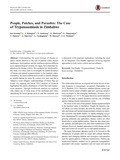People, Patches, and Parasites: The Case of Trypanosomiasis in Zimbabwe
| dc.contributor.author | Scoones, Ian | |
| dc.contributor.author | Dzingirai, V | |
| dc.contributor.author | Anderson, N | |
| dc.contributor.author | MacLeod, E | |
| dc.contributor.author | Mangwanya, L | |
| dc.contributor.author | Matawa, F | |
| dc.contributor.author | Murwira, A | |
| dc.contributor.author | Nyakupinda, L | |
| dc.contributor.author | Shereni, W | |
| dc.contributor.author | Welburn, S C | |
| dc.coverage.spatial | Zimbabwe | en |
| dc.date.accessioned | 2018-05-01T12:10:52Z | |
| dc.date.available | 2018-05-01T12:10:52Z | |
| dc.date.issued | 2017-09 | |
| dc.identifier.citation | Scoones, I, Dzingirai, V, Anderson, N, MacLeod, E, Mangwanya, L, Matawa, F, Murwira, A, Nyakupinda, L, Shereni, W & Welburn, S 2017, 'People, patches and parasites: the case of trypanosomiasis in Zimbabwe' Human Ecology, vol 45, no. 5, pp. 643-654. | en |
| dc.identifier.uri | https://opendocs.ids.ac.uk/opendocs/handle/20.500.12413/13693 | |
| dc.description.abstract | Understanding the socio-ecology of disease requires careful attention to the role of patches within disease landscapes. Such patches, and the interfaces between different socio-epidemiological systems, we argue, have important implications for disease control.We conducted an interdisciplinary study over three years to investigate the spatial dynamics of human and animal trypanosomiasis in the Zambezi valley, Zimbabwe. We used a habitat niche model to identify changes in suitable habitat for tsetse fly vectors over time, and this is related to local villagers’ understandings of where flies are found. Fly trapping and blood DNA analysis of livestock highlighted the patchy distribution of both flies and trypanosome parasites. Through livelihoods analysis we explored who makes use of what areas of the landscape and when, identifying the social groups most at risk. We conclude with a discussion of the practical implications, including the need for an integrated ‘One Health’ approach involving targeted approaches to both vector control and surveillance. | en |
| dc.language.iso | en | en |
| dc.publisher | Springer US | en |
| dc.rights | This article is distributed under the terms of the Creative Commons Attribution 4.0 International License (http://creativecommons.org/licenses/by/4.0/), which permits unrestricted use, distribution, and reproduction in any medium, provided you give appropriate credit to the original author(s) and the source, provide a link to the Creative Commons license, and indicate if changes were made. | en |
| dc.rights.uri | http://creativecommons.org/licenses/by/4.0/ | en |
| dc.subject | Health | en |
| dc.subject | Rural Development | en |
| dc.title | People, Patches, and Parasites: The Case of Trypanosomiasis in Zimbabwe | en |
| dc.type | Article | en |
| dc.rights.holder | © The Author(s) 2017 | en |
| dc.identifier.externaluri | https://www.tandfonline.com/doi/full/10.1080/03066150.2017.1339693?scroll=top&needAccess=true | en |
| dc.identifier.team | Resource Politics | en |
| dc.identifier.doi | 10.1007/s10745-017-9929-y | |
| rioxxterms.funder | Default funder | en |
| rioxxterms.identifier.project | Default project | en |
| rioxxterms.version | VoR | en |
| rioxxterms.versionofrecord | https://doi.org/10.1007/s10745-017-9929-y | en |
| rioxxterms.funder.project | 9ce4e4dc-26e9-4d78-96e9-15e4dcac0642 | en |
Files in this item
This item appears in the following Collection(s)
Except where otherwise noted, this item's license is described as This article is distributed under the terms of the Creative Commons Attribution 4.0 International License (http://creativecommons.org/licenses/by/4.0/), which permits unrestricted use, distribution, and reproduction in any medium, provided you give appropriate credit to the original author(s) and the source, provide a link to the Creative Commons license, and indicate if changes were made.


